�
A. Street extensions. The arrangement of streets within a development shall provide for the extension and/or realignment of existing streets, except that local and local collector streets should only be extended when such extension is necessary and the Planning Board concurs that such extension will promote safety and conform to the street standards contained elsewhere in this chapter.�
B. Street widening. Where developments abut existing roadways, sufficient rights-of-way shall be reserved to provide the right-of-way width proposed for the functional classification of the street in question. For all properties on Route 9 between the Garden State Parkway and the Township of Lakewood the reserved right-of-way shall be 57 feet from the existing centerline of the highway.�
**Webmasters Note: The previous subsection has been amended as per Ordinance No. 4064- 06�
C. Design of local streets. Local streets shall be designed in accordance with the Schedule of Street Design Standards and the following requirements:�
(1) Local streets shall be arranged so that there exists a minimum possibility of their use by traffic which does not have its origin or destination at the lots to which the local streets provide access.�
(2) Cuts-de-sac (dead-end streets) should have center line length, from the intersecting street center line to the center point of the turnaround of the cut-de-sac, of not less than 100 feet nor longer than 1,200 feet and should not provide access to more than 25 lots. They shall provide an end turnaround with a pavement radius of riot less than 65 feet and a property line radius of not less than 75 feet, which shall have its center point at or to the left of the center line of the street, when view I toward the closed end. In the event that it is contemplated that a dead-end street shall be extended in the future, a temporary turnaround, meeting the aforementioned design criteria, shall be required. [Amended 7-26-1995 by Ord. No. 3118-95]�
(3) Loop streets should provide access to not more than 45 lots, except that where access is provided by a combination of a short loop street and cull-de-sac, the maximum shall be 60 lots, provided that the length of the loop street alone will no, exceed 3,000 feet. Loop streets shall have both of their termini located on the same street.�
(4) P-loops, which are loop streets with a single access point, should have an entrance not exceeding 700 feet in distance from the loop intersection. There should also be provided an emergency vehicular and pedestrian right-of-way of 15 feet minimum width from the loop and providing access to a street which is not a part of the P-loop. The loop of a P-loop should have a street length not exceeding 3,000 feet. P-loops should provide access to no more than 60 lots, and the entrance street should be designed in accordance with the design standards for minor collector streets.�
(5) Artificial modifications in street rights-of-way for the purpose of increasing lot frontage shall be prohibited. Such prohibited modifcation shall include but shall not be limited to widening the right-of-way of a continuous street through the use of semicircular projections.�
(6) Reduced paving width. When a cut-de-sac or loop street provides access to 25 or fewer lots, the Planning Board may consider the use of reduced paving width where, by reason of' topography, physical features or other conditions, the reduced paving width would substantially reduce disruption of the development's environment. In no case shall the paving width of a two-way cut-de-sac or loop street be reduced to less than 28 feet. The Planning Board may consider the use of one-way loop streets with a minimum paving width of 22 feet. Such one-way streets with reduced paving width are subject to the review and approval of the Traffic Bureau of the New Jersey Department of Transportation. Such review and approval must be obtained by the developer before approval of a final plat will be granted.�
D. Classification of streets. In any development it shall be the duty of the Planning Board to approve classification of proposed streets according to their use. In making its decisions, the Planning Board shall refer to the Master Plan and shall consider conditions within the development and the surrounding areas and shall use as a guide the following street classifications and criteria:�
(1) Local street. A local street is a street serving only single-family residences and where feasible should be either a cut-de-sac or a loop street meeting the requirements hereinabove set forth. A street which serves traffic having origins and destinations other than within the lots which abut the street shall not be considered a local street. The maximum traffic normally expected on a local street shall be 400 vehicles per day.�
(2) Local collector or minor collector street. A local collector or minor collector is generally a street gathering traffic from local streets and feeding it into a system of major collectors, minor arterial and major arterial highways. Even if laid out as a local street, a street should be considered a local or minor collector street if it provides access or could provide access to more than 60 lots or, in the case of a cut-de-sac, more than 25 lots, or could be utilized by traffic other than residential in nature. Local or minor collector streets should generally not be expected to carry traffic exceeding 1,000 vehicles per day. The design speed of local or minor collectors, for alignment and sight distance purposes, should be 40 miles per hour.�
(3) Major collector streets. A major collector street is generally a street gathering traffic from local streets or minor collector streets and feeding it into a system of arterial highways. Even if laid out as a local or minor collector street, a street should be considered a major collector street if it provides access or could provide access to more than 150 lots or would be utilized by traffic other than residential in nature. Major collector streets should generally not be expected to carry traffic exceeding 2,500 vehicles per day. The design speed of major collector streets, for alignment and sight distance purposes, should be 50 miles per hour.�
(4) Minor arterials. Minor arterials are streets gathering traffic from more than one local, minor or major collector street and leading it to a system of other minor arterials or principal arterial streets. Minor arterials shall have a design speed, for alignment and sight distance purposes, of 60 miles per hour and should generally be designed to carry traffic volume approaching 10,000 vehicles per day.�
(5) Principal arterial highways. Principal arterials are any federal, state or county highways or municipal streets or roads intended to carry traffic between other major arterials and minor arterials and between the various neighborhoods of the Township or from the Township's neighborhoods to destinations outside the Township. Principal arterial highways should have a design speed of 60 miles per hour and should be designed to carry traffic exceeding 10,000 vehicles per day.�
(6) Classification criteria. Street classifications will be approved by the Planning Board in accordance with the foregoing definitions, in accordance with the provisions of the Master Plan and Official Map if such are adopted, in accordance with the provisions of applicable county and state regulations or plans or, in the absence of specific information from the above, in accordance with its own best judgment concerning the use to which the various streets in any development will be put.�
E. Lots abutting major collector, minor arterial and arterial highways. In any subdivision abutting or being traversed by a major collector street, minor arterial or principal arterial highway, one of the following conditions shall be required by the Board:�
(1) A marginal street meeting the classifications herein for a local street shall be provided along each major collector, minor arterial or principal arterial highway and shall be separated from the major collector, minor arterial or principal arterial highway by a landscaped strip at least 25 feet in width.�
(2) The frontage of all lots abutting the major collector, minor arterial or principal arterial highway shall be reversed so that the lots will front on an internal local street; a natural wooded or landscaped buffer strip at least 50 feet in width will be provided on the abutting lots along the right-of-way of the major collector, minor arterial or principal arterial highway. The area of such buffer strip shall not be considered part of the required minimum lot size.�
(3) All lots abutting major collector streets may, in lieu of the above, be provided with suitable driveway turnarounds eliminating any necessity for vehicles to back into the collector street.�
(4) Other means of providing a satisfactory buffer separating through and local traffic shall be provided as may be deemed proper by the planning Board.�
(5) Dwellings on corner lots shall have their driveway access on the roadway designed and intended to carry the lesser amount of traffic.�
F. Street design standards. Street design standards shall be appropriate to the expected use of the street, soil, topographical and other physical conditions and to the maintenance of the purposes of this chapter but shall not be less than those set forth in the Schedule of Street Design Standards (Figure No. 9).�
G. Street intersections. Street intersections shall be designed according to the following standards:�
(1) No more than two streets shall cross the same point. Street intersections shall be at right angles wherever possible, and intersections of less than 70, measured at the center line of streets, shall not be permitted.�
(2) Streets should not enter the same side of local, minor or major collector streets at intervals of less than 500 feet, minor arterials at intervals of less titan 1,200 feet or principal arterials at intervals of less than 2,500 feet. Streets which enter collectors, minor arterials or principal arterials from opposite sides shall be directly opposite to each other or must be separated by at least 300 feet between their center lines measured along the center line of an intersected collector or 500 feet along the center line of a minor arterial or 800 feet along the center line of a principal arterial.�
(3) Approaches of any major collector, minor arterial or principal arterial street to any intersection of another major collector, minor arterial or principal arterial street shall be tangent or have a center line radius greater than 5,000 feet for al least 500 feet from the intersection.�
(4) Where a minor or major collector, major thoroughfare or major arterial street intersects with a major collector, major thoroughfare or major arterial street, the right-of-way of each minor collector shall be widened by 10 feet (five feet for each side) for a distance of 300 feet in all directions from the intersection of the center lines, and the right-of-way of each major collector, minor arterial and principal arterial shall be widened by 20 feet (10 feet for each side) for 500 feet in all directions from the intersection of the center lines.�
(5) Approaches of any local, local collector or minor collector street to any other street shall:�
(a) Be tangent (straight) for a distance of at least 50 feet from the intersection, or�
(b) Have a center-line radius greater than 1,000 feet for at least 150 feet from the intersection, and�
(c) Have a clear sight of a point three feet high in the intersection for a distance of not less than 400 feet.�
H. Street layout.�
(1) Curved local, local collector and minor collector streets are preferred to discourage speed and monotony. The maximum straight-line distance should not exceed 1,000 feet.�
(2) The Planning Board in all cases may, and in the case of subdivisions having 100 or more lots shall, require provisions for continuing circulation patterns onto adjacent properties and, for this purpose, may require the provision of stub streets abutting adjacent properties.�
(3) Subdivisions containing more than 150 lots should have two access points from collector streets or arterial highways.�
I. Street names. Street names and development names shall not duplicate, nearly duplicate or be phonetically similar to the names of any existing streets or development in Dover Township or contiguous areas of other communities. Any continuation of an existing street shall have the same street name.�
J. Limit of improvements. The developer shall complete all improvements to the limits of the development, unless other provisions have been made and approved by the planning Board. In those instances where completion of certain improvements would not be possible until the development of adjacent land takes place, alternate temporary improvements may be constructed subject to the approval of the Planning Board, and cash or a certified check representing the difference between the value of the temporary improvements and the required improvements may be accepted by the Township Committee to be credited toward the completion of such improvements at such time as the adjacent land develops. ,�
K. Streets serving other than single-family detached homes. The right-of-way width and other standards for internal roads and alleys in multifamily, commercial and industrial developments shall be determined by the Board on an individual basis and shall in all cases be of sufficient width and design to safely accommodate maximum traffic, parking and loading needs and maximum access for fire-fighting equipment and shall generally conform to the requirements herein.�
L. Reserve strips. There shall be no reserve strips or areas controlling access to streets except where control and disposal of the land comprising such strips or areas have been placed in the hands of the governing body under conditions approved by the Planing Board.�
�
Streetlights shall be of a type approved by resolution of the Township Committee and by the electric utility company serving the proposed development installed on poles 30 feet in height and approved by the Township Planning Board and located so as to provide a minimum lighting level of 0.5 horizontal footcandle on all local, local collector and minor collector streets and one horizontal footcandle on all major collector, minor arterial and principal arterial streets. The developer shall pay the full cost for initial installation of any streetlights and, in accordance with § 348-7.6H herein, the operation and maintenance costs until such time as the municipality assumes payment for the operation and maintenance costs of such streetlighting.�
A. Street-name signs shall be reflectorized four-way type (two head), aluminum construction known as a "tomcat," vandal-proof street-name sign or equivalent, will] the following features:�
(1) The construction of the tomcat vandal-proof, street-name sign shall be as manufactured with all extensions to be made of 6063-T5 aluminum alloy with a solid three-fourths-inch-diameter metal threaded center staff, consisting of a compression spring and locking nut for mounting inside the wall of the post.�
(2) Lettering on street-name signs shall be at least four inches, with supplementary lettering to indicate the type of street (e.g., street, avenue, road, etc.), which shall be in smaller lettering at least two inches in height. Conventional abbreviations are acceptable, except for the street name itself.�
(3) The reflectorized legend and background shall be of a contrasting color and should have a white message and border on a green background. The sign faces shall be of a high-intensity type, fabricated from scotch lites brand reflective sheeting, high-intensity grade as manufactured by 3M or an approved equal. All numbers and letters shall be of a heat-sealed type.�
(4) The posts shall be of a galvanized-steel type or approved equal and shall be of a length of 12 feet, installed in a concrete base.�
B. Street signs shall be properly installed at each street intersection. Street signs shall be placed, two per intersection, on the near right-hand corner, as viewed from both directions, on the street which is expected to carry the greatest traffic through the intersection. Mounting shall be in accordance with the standard procedures of the Township or with requirements adopted by the Township Committee. Street signs shall be placed before any certificate of occupancy for houses on the subject street are issued.�
The developer shall, prior to final acceptance, install all traffic control devices required within any development or, with the consent of the Township Committee, may pay to the Township Treasure a nonrefundable sum, in cash or certified check, in the amount set by the Township Engineer equal to the cost of all necessary traffic control devices not installed by the developer. Traffic control devices shall include but are not limited to signs, traffic lines, lights, reflectors and channelizing markers. The number, type, legend, placement and size of all traffic control devices shall be in accordance with the Manual on Uniform Traffic Control Devices by the United States Department of Transportation and the requirements of municipal, county and state regulations and shall be according to an approved plan submitted at the time of final plat approval. Construction details of all proposed traffic control devices shall be in accordance with standards prepared by the Township Engineer and approved by the Township Committee.�
With the exception of water distribution systems which shall be governed by Section 348-8.34 of this Chapter, all utility lines and necessary appurtenances, including but not limited to electric transmission and electric, gas, communications, street lighting and cable television, shall be installed underground within easements or dedicated public rights-of-way. The developer shall arrange with the serving utility for the underground installation of the utility's supply lines and service connections in accordance with the provisions of the applicable standard terms and conditions of its tariff, as the same are then on file with the State of New Jersey Board f Public Utility Commissioners, and shall submit to the Planning Board, prior o the granting of approval, a written instrument from each serving utility which shall evidence full compliance with the provisions of this section; provided, however, that lots which abut existing easements or public rights-of-way where overhead utility lines have theretofore been installed may be supplied with service from such overhead lines if no new utility poles are required. In any event, new building service connections for all multifamily developments, shopping centers, industrial parks and planned retirement communities, and for any industrial, commercial or office development containing a floor area of 10,000 square feet or more, shall be installed underground. All other new building service connections shall also be installed underground unless specific waiver is granted by the Planning Board. Wherever the utility is not installed in the public right-of-way, an appropriate utility easement not less than 25 feet in width shall be provided. �
**Webmasters Note: The previous section has been amended as per Ordinance No. 4118-07.�
A. Prior to the approval of any final plat of site plan or subdivision which requires the installation of any public and/or individual water supply systems, an extension of existing systems, the developer shall submit the design plans of said water supply systems to (1) the Township's Water Utility Franchisee and (2) the Planning Board or Board of Adjustment, if applicable, for the review and approval of the aforesaid respective utility and agencies.�
B. Upon the approval of the developer's design plans, the Water Utility Franchisee shall notify the Planning Board or Board of Adjustment, if applicable, and the Township Engineer, in writing. Said written approval shall also include confirmation that the Water Utility Franchisee will provide public water supply service to the developer's property.�
C. The developer shall also provide proof of approval of any and all other federal, state, county or local approval relating to Public water supply service.�
D. Prior to the approval of any final plat of site plan or subdivision, if applicable, or prior to the issuance of any building permit, the developer shall dedicate all water supply utility lines and related appurtenances to the Township of Toms River. The applicant shall also convey all necessary easements to the Township of Toms River. All dedications shall be in a form approved by the Township Attorney. Upon dedication, the Township shall lease the installed water supply utility lines and related appurtenances to the Township water utility franchisee upon terms and conditions as agreed to by the Township and utility franchisee.�
E. The developer shall arrange with the Water Utility Franchisee for the underground installation of the water supply lines, related appurtenances and service connections in accordance with the provisions of the applicable standard terms and provisions of its tariff, as the same are then on file with the State of New Jersey Board of Public Utility Commissioners.�
F. All water utility lines and related appurtenances shall be installed within dedicated public right-of-ways or within easement dedicated to the Township of Toms River.�
**Webmasters Note: The previous section has been amended as per Ordinance No. 4118-07.�
In zoning districts where the placement of umbrellas is a permitted accessory use, the following minimum requirements shall apply:�
A. No more than three umbrellas shall be permitted on any site.�
B. Umbrellas shall have a maximum height of 16 feet.�
C. No umbrellas shall be greater than 18 feet in diameter or width.�
D. No umbrellas shall be located closer than 25 feet to any street right-of-way.�
E. Umbrellas shall adhere to the minimum side and rear setback requirements for principal buildings within the highway business zone.�
�
F. No lettering or words shall be permitted on any umbrella which would be used to identify or advertise the place of business.�
G. No umbrella shall be closer than 25 feet to any other umbrella as measured from the tip of the umbrella to the tip of the adjoining umbrella.�
H. No umbrella shall be placed closer than 25 feet to any principal structure.�
I. In the event that three umbrellas are placed on any one site, the total minimum front setback from any street right-of-way shall be a minimum of 100 total feet; provided, however, that no individual umbrella shall be located closer than 25 feet to any street right-of-way.�
In zoning districts where the placement of tents is a permitted accessory use, the following minimum requirements shall apply:�
A. No tent(s) erected upon any site may exceed 2,000 square feet.�
B. Tents shall have a maximum height of 20 feet.�
C. No tent(s) shall have a dimension greater than 60 feet.�
D. No tent(s) shall be located closer to any property line than the required principal building setback or within any vehicular circulation aisle.�
E. No tent(s) may be utilized to advertise or identify the name of or the place of business.�
F. No tent(s) may be erected upon any site closer than 25 feet to another tent, umbrella and/or any building on the site upon which the tent is erected.�
G. Tents erected on any residential parcel for not more than five days for residential purposes shall be exempt from Subsections D, E and F and shall be considered permitted accessory uses.�
In accordance with the provisions of state and federal regulations, the following standards shall be utilized in the design of all facilities to provide access for the physically handicapped.�
A. Curb ramps for the physically handicapped.�
(1) Curb ramps for the physically handicapped shall be constructed on all street curb returns and, where appropriate, in parking areas. In general, two curb ramps shall be constructed at each corner. A single ramp at the center of the corner is acceptable when site conditions preclude the use of the two-ramp system.�
(2) Curb ramps for the physically handicapped shall be constructed in accordance with the standards shown on Figures 7A, 7B or 7C. If there is a grass or landscaped area between the curb and the sidewalk, side ramps need not be provided. Curb ramps shall be provided at all four corners of full intersections and at the two corners plus a location across the street from both of the ramps at T-intersections.�
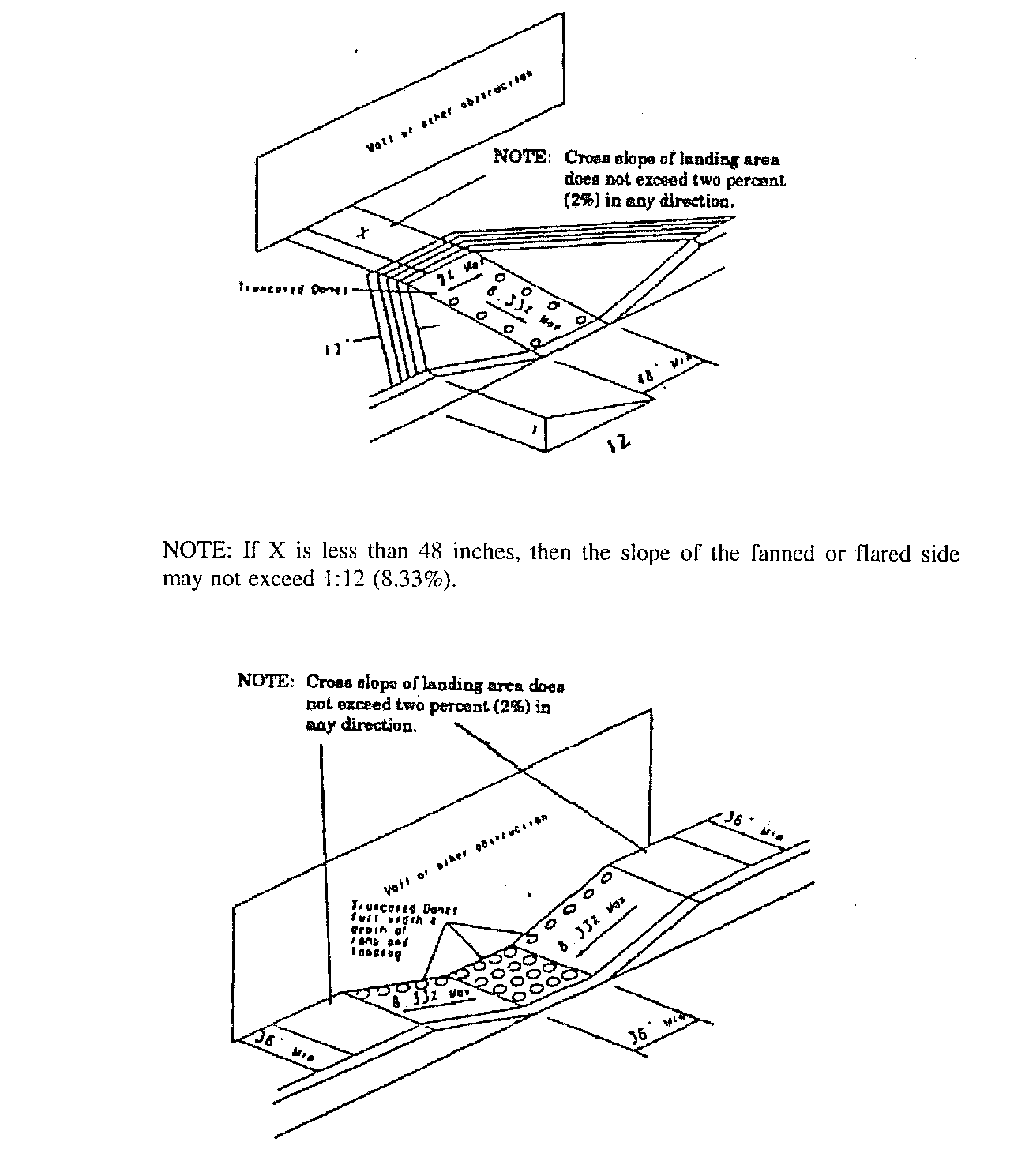
NOTE: Built-up ramps are not allowed to encroach into loading/unloading zones, parking spaces or vehicular traffic areas.�
B. Handicapped parking spaces. Parking spaces for the physically handicapped shall be provided in accordance with the following table:�
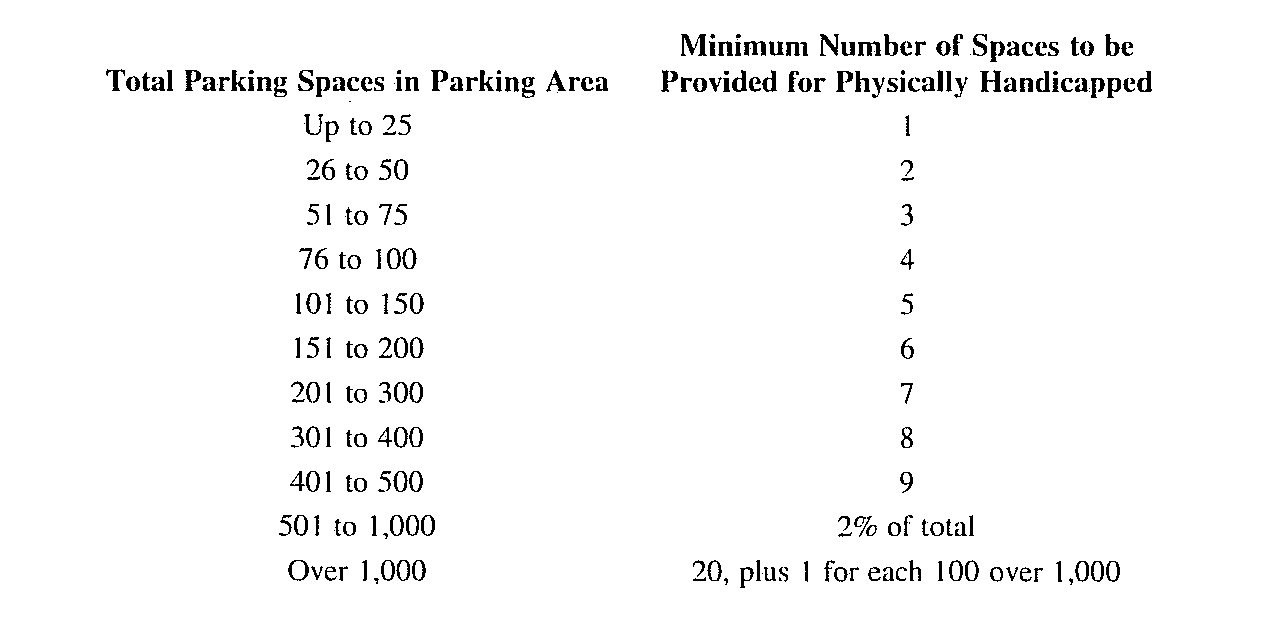
C. Parking space design.�
(1) The length of each parking space shall be 18 feet as measured in accordance with
(2) Each parking space shall have a minimum width of eight feet and shall be adjoined by a minimum five-foot-wide access aisle. The access aisle shall be located on the passenger side of the parking space. (See Figure 7F.)�
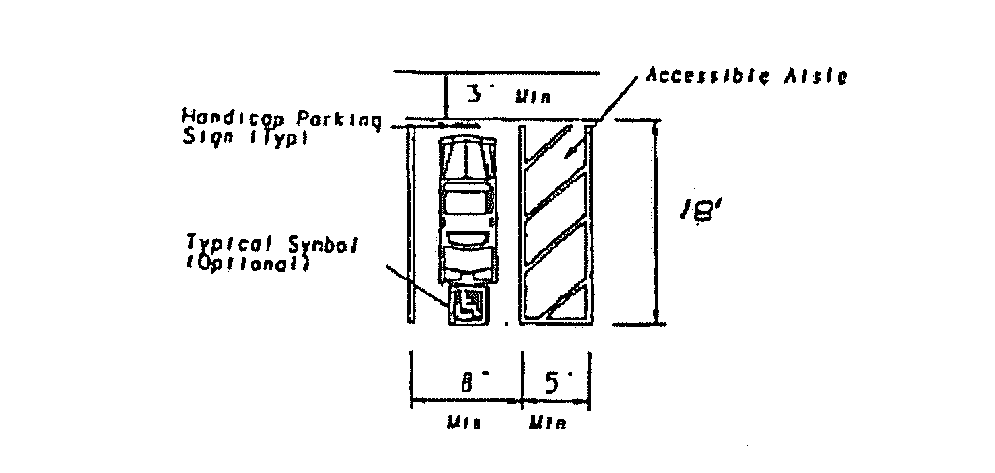
GENERAL PARKING NOTES:�
1) Handicapped space must permit use of either of car doors.�
2) A bumper is required when no curb or barrier is provided which will prevent encroachment of cars over walkway.�
3) A maximum crossfall of 2% is allowed in parking space and access aisle.�
4) Loading/unloading area must connect to an accessible path of travel.�
�
5) Refer to handicap formula in Item #2.�
(3) For double parking space design, a minimum twenty-one-foot width shall be provided for two spaces and access aisle area. The access aisle shall be located between the parking spaces. (See Figure 7G.)�

Parking Space - Double FIGURE 7G�
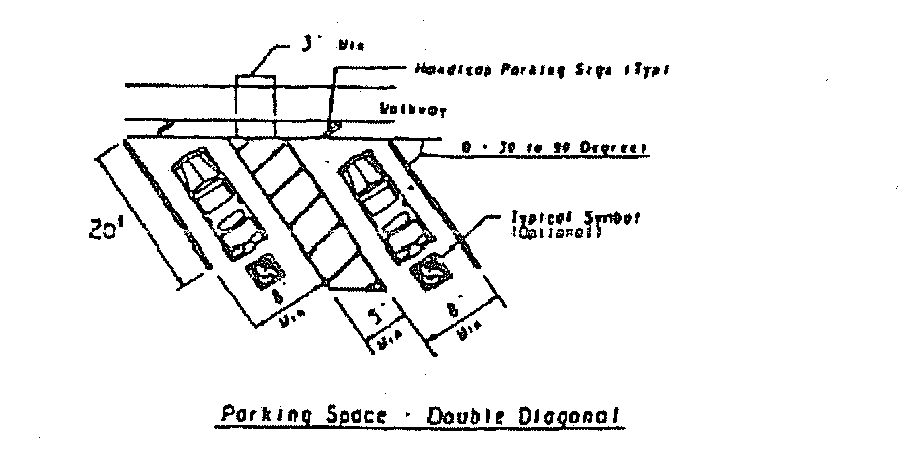
(4) Van-accessible parking spaces.�
(a) One of every eight handicapped parking spaces provided, but not less than one, shall be a van-accessible parking space.�
(b) Each van-accessible parking space shall have a minimum width of eight feet with passenger side access of a minimum eight feet wide. (See Figure 7H.) Alternate parking design specifications may be provided in accordance with Figure 71 providing a total twenty-seven-foot-wide width for two stalls or a minimum sixteen-foot width for single parking stalls.�
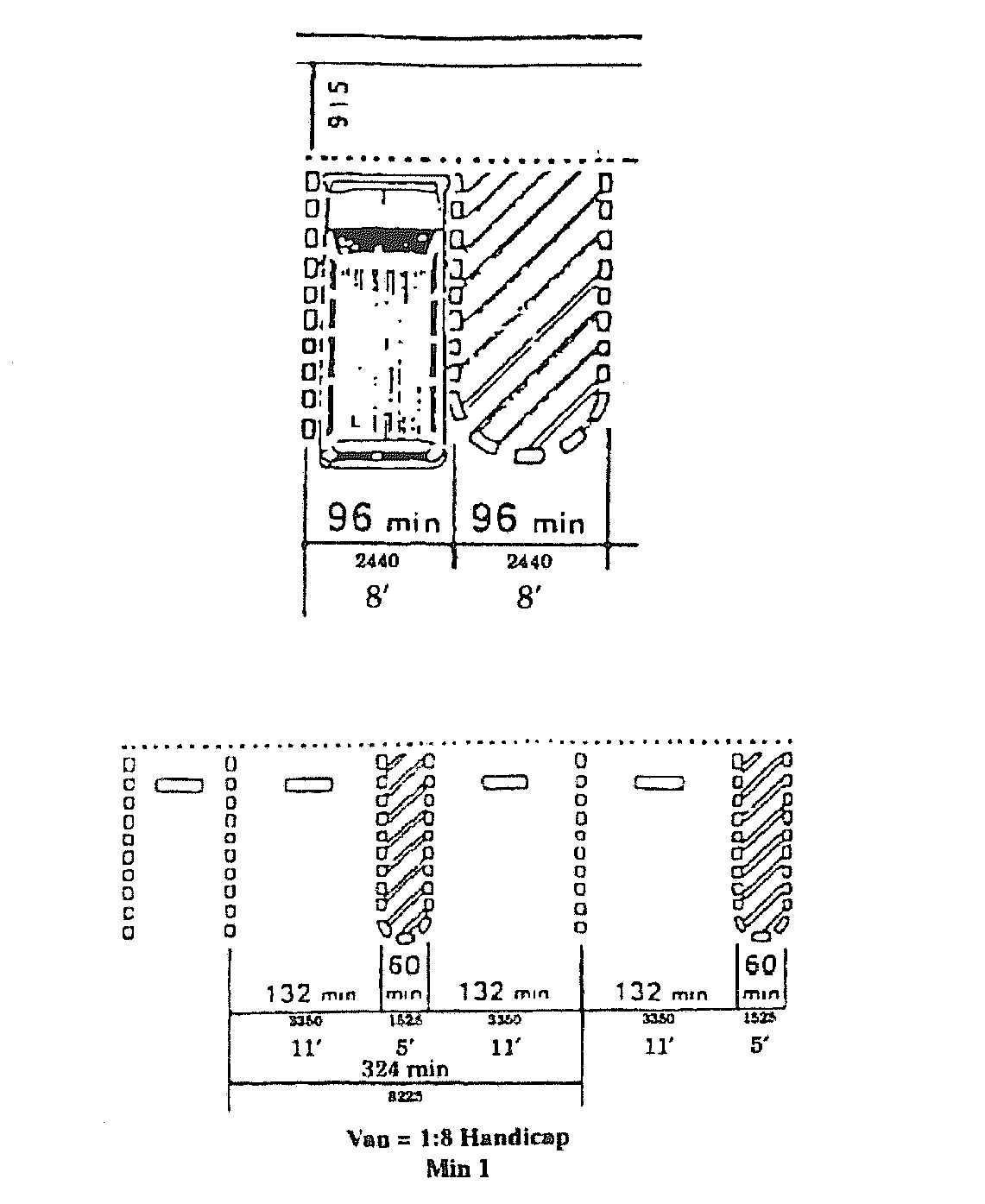
D. Parking space sign age. Each reserved handicapped parking space shall be provided with signage in accordance with Figure 7J, and every van-accessible parking stall shall be provided with signage identifying the stall as van-accessible. The parking spaces shall also be delineated by light blue striping, and an emblem with minimum dimensions of 36 inches by 36 inches being a profile view of a wheelchair and occupant in white on a light blue background shall be installed on each handicapped space and shall be located such that the base of said emblem is located at the open end of the parking stall. (See Figure 7K.)�

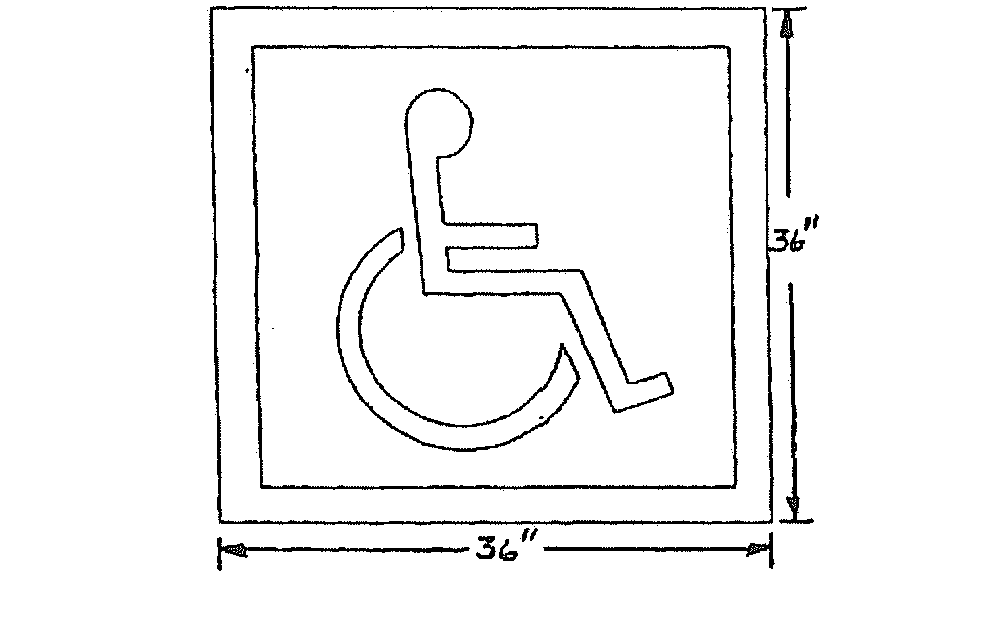
E. Accessible route. At least one accessible route within the boundary of each site developed shall be provided from public transportation stops, accessible parking and accessible passenger loading zones and public streets and sidewalks to the accessible building entrance they serve.�
(1) Width. The minimum clear width of an accessible route shall be three feet and shall provide a passing space having minimum dimensions of five feet by five feet at reasonable intervals not to exceed 200 feet.�
(2) Surface. The surface texture shall be stable, firm and slip-resistant.�
(a) Changes in level. Changes in level of less than inch may be vertical, of between inch and inch shall be beveled with a slope no greater than 1:2. For changes in level of greater than inch, a ramp in accordance with the requirements herein shall be required.�
(b) Gratings. If gratings are located within the accessible route, they shall have spaces no greater than inch wide in one direction, and if the grading has elongated openings, the long dimension shall be perpendicular to the route of travel.�
(c) Slope. The maximum cross slope of an accessible route shall be 1:50, and any accessible route with a running slope of greater than 1:20 shall be considered a ramp and comply with the requirements herein for the same.�
(3) Detectable warning. If an accessible route crosses or adjoins a vehicular way and the pedestrian area and vehicular area are not separated by curbs, railings or other elements, the boundary between the areas shall be defined by a continuous detectable warning having a minimum width of three feel and installed in accordance with Figure 7D above.�